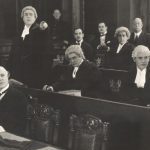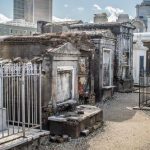 Music
Music  Music
Music  History
History 10 Less Than Jolly Events That Occurred on December 25
 Weird Stuff
Weird Stuff 10 Funny Ways That Researchers Overthink Christmas
 Politics
Politics 10 Political Scandals That Sent Crowds Into the Streets
 Weird Stuff
Weird Stuff Ten Bizarre Facts About The Doge Meme
 Our World
Our World 10 Ways Your Christmas Tree Is More Lit Than You Think
 Movies and TV
Movies and TV The 10 Coolest Stars to Set Sail on The Love Boat
 History
History 10 Things You Didn’t Know About the American National Anthem
 Technology
Technology Top 10 Everyday Tech Buzzwords That Hide a Darker Past
 Humans
Humans 10 Everyday Human Behaviors That Are Actually Survival Instincts
 Music
Music 10 Surprising Origin Stories of Your Favorite Holiday Songs
 History
History 10 Less Than Jolly Events That Occurred on December 25
 Weird Stuff
Weird Stuff 10 Funny Ways That Researchers Overthink Christmas
Who's Behind Listverse?

Jamie Frater
Head Editor
Jamie founded Listverse due to an insatiable desire to share fascinating, obscure, and bizarre facts. He has been a guest speaker on numerous national radio and television stations and is a five time published author.
More About Us Politics
Politics 10 Political Scandals That Sent Crowds Into the Streets
 Weird Stuff
Weird Stuff Ten Bizarre Facts About The Doge Meme
 Our World
Our World 10 Ways Your Christmas Tree Is More Lit Than You Think
 Movies and TV
Movies and TV The 10 Coolest Stars to Set Sail on The Love Boat
 History
History 10 Things You Didn’t Know About the American National Anthem
 Technology
Technology Top 10 Everyday Tech Buzzwords That Hide a Darker Past
 Humans
Humans 10 Everyday Human Behaviors That Are Actually Survival Instincts
Ten Fascinating Facts about America’s First Mega-Prison
Eastern State Penitentiary, or ESP, in Philadelphia, was America’s first large-scale penitentiary. The country had built jails before, of course. Jails of various kinds have long predated the United States, too. But never before was a mega-prison built on the scale the state of Pennsylvania used when they first constructed it in the late 18th century. In many ways, the penitentiary became the blueprint for the modern mega-prisons that dot the United States landscape today.
In many ways, the horrors inmates suffered at Eastern State have become the model for incarceration across the country over the past several centuries. Eastern State started its humble existence as Philadelphia’s Walnut Street Jail in 1776. By 1790, pressed with a need to expand, city officials added a “Penitentiary House” to the jail. Cells in that block were very tiny. The smallest measured just 6 x 8 feet (1.8 x 2.4 meters). They were intended to pack criminals into holes of solitary confinement for years of lonely punishment. As Philadelphia grew rapidly following America’s independence from Britain, the jail kept expanding. By 1821, it became its final form: Eastern State Penitentiary.
It was a massive prison set in the center of Philadelphia that shuttled in all sorts of violent and dangerous inmates. Jailers were keen on solitary confinement at that time, and many of the cells in the prison shrunk even further to no bigger than 4 feet (1.2 meters) wide. Inmates were stuffed in like sardines and left to live mostly alone for years on end. Suicides and violent deaths became common as men lashed out in anguish. The mental health toll on those suffering inside was incalculable.
But the mega-prison proved popular with city leaders who wanted to incarcerate the community’s worst offenders. Soon, prisons in other states, from Massachusetts to Tennessee, copied ESP’s setup. Before long, it was the model for every mega-prison built in America. Today, even though ESP has been closed for fifty years, its memory still haunts Philadelphia. Today, let’s take a deep dive into ten fascinating and jaw-dropping facts about the construction, development, growth, and eventual demise of America’s first penitentiary.
Related: 10 Ghastly Prison Practices Of The 19th Century
10 A Big Idea at Walnut Street Jail
When it came time to expand the Walnut Street Jail in 1821, the city of Philadelphia and the state of Pennsylvania put up $100,000. That was an astonishing amount of money at the time, of course. And the city wanted to recoup its investment by ensuring the prison would do its job. The Walnut Street Jail had been small, overcrowded, and ineffective. But the new Eastern State Penitentiary was to be a revolution in incarceration.
And much of the thinking on large-scale solitary confinement at the time came from one man: Thomas Bradford. He had been an inspector at the Walnut Street Jail and worked for an organization that later became the Philadelphia Prison Society. He felt inmates had been ineffectively managed at Walnut Street. Thus, he said, it was time for a new way of housing prisoners: by keeping them apart. Of course, Bradford and his ilk didn’t know then what we know now about solitary life and the mental perils that come from it. But they didn’t care. They were focused on rehabilitating whomever they could and shutting in the rest.
For Bradford and his adherents, Walnut Street and other American jails had failed before ESP’s growth. Those in favor of solitary confinement in the new mega-prison wanted it to come with two other key tenets: religious instruction and education in a trade skill. These three factors together soon became known as the “Pennsylvania system” of prisoner development. As construction workers built ESP to jailers’ specifications, Bradford molded the prison to fit those three goals.
Prison officials hoped life inside the mega-structure would inspire penitence among its cast-offs. Solitary confinement, they reasoned, would allow men to think of their misdeeds and correct them. Religious instruction could give these wayward souls a new faith-based life to follow. And by teaching them trades like carpentry and blacksmithing, men could leave prison with skills needed to survive on the outside.[1]
9 Soon, No Expense Is Spared
For much of the 1820s, workers hurried to update and expand the Walnut Street Jail. By 1829, the expanded prison was mostly ready to open for “business,” as you might say. ESP had a radically original design for the time. It consisted of seven cell blocks built out in a “radial” design like spokes on a bicycle wheel. Each block was composed of 76 different cells. To ensure complete separation of the prisoners, cells were split up with 18-inch (45.7-centimeter) thick stone walls. Inmates couldn’t communicate with each other that way, prison officials reasoned.
The plan was for jail residents to live in their cells virtually all day, every day. So construction workers put toilets and sinks in each tiny cell. They offered the men very limited hygiene. ESP wasn’t officially complete until 1836, even though it began admitting prisoners seven years earlier. When the dust settled on the construction, the cost was immense: $780,000. Today, that would be nearly $25 million. When it was finished, ESP was one of the most expensive buildings in the United States.
Late in 1829, Eastern State Penitentiary officially took in its first prisoner. The man given that unfortunate distinction was Charles Williams. He was an 18-year-old Black farmer who was sent to the mega-prison in October of that year. He’d been sentenced to two years of solitary confinement for stealing a gold key and a silver watch. The value of the stolen goods was about $25—or just a little over $800 in today’s money.
But city officials very badly wanted to punish scofflaws, and Philadelphia residents were keen on dishing out tough justice. So Williams and others were there to be made examples. The young man was treated as a violent offender when he was rushed into the jail. Guards placed a hood over his head to prevent him from learning the prison’s unique layout. In the years after his relatively short sentence, thousands of other men followed Williams behind those bars. Many of them had committed far more violent crimes than stealing a watch.[2]
8 Life in Solitary
By the end of construction, most of the cells at ESP ended up measuring 12 x 8 feet (3.7 x 2.4 meters). Those living in the prison were left inside their tiny holes for 23 hours a day, on average. They were limited to just an hour of exercise in the yard on most days—but only if they behaved accordingly. The prison also offered religious services to its inmates and expected them to follow along. The hope for Philadelphia Prison Society officials like Bradford was that the prison was perfectly designed to “induce and effect reform in the minds of the prisoners.”
By being alone in solitary confinement for nearly 99% of the day, inmates could somehow consider the misdeeds that had landed them there and vow to make good in the future. That’s not to say they weren’t busy, though. While stuck in their cells, prisoners were forced to work with their hands. They had to choose between making chairs, textile products, or shoes every day. Then, prison guards would sell the items around Philadelphia. The profits brought in from those sales would fund prison upkeep, meals for inmates, and other budgetary necessities.
Amazingly (or perhaps not), guards typically prevented inmates from accessing any reading or writing materials. Wardens didn’t want inmates writing letters to the outside world or doing any deeper thinking beyond pre-determined religious lessons. To that end, prison officials also forbade family members from visiting their loved ones inside. The jailers wanted to intensify the awful effects of isolation, and keeping inmates from their families was thought to be an effective way to drive that point home.
Even during the inmates’ mandatory religious services, they were kept in very restricted environments. Prisoners would assemble for mass or Sunday school teachings and be re-isolated. Guards placed chairs far apart, put prisoners in hoods and blinders, and partitioned off community rooms during church. This kept prisoners from seeing each other or communicating. As it was, prisoners mostly had no idea who else was living inside the facility or how many other inmates there were—because they rarely ever saw or heard from them.[3]
7 Terrorized Inmates & Tortured Souls
Solitary confinement in a tiny prison cell for 23 hours a day for years on end is its own form of torture. But in the early 19th century, prison officials didn’t see it that way. Solitary, they felt, was the best way to break down unruly men and wash away their sins. So when inmates caused trouble at ESP, guards opted for even more draconian punishment techniques. For some, that meant using an early waterboarding technique of sorts.
A bad prisoner would be chained to a wall or chair. Then, guards would turn on a fire hose of cold water, flooding the inmate and shocking their system with the icy temperatures. If inmates still misbehaved, they’d be tied up in an iron gag. A metal ring was placed tightly around their neck and linked via chains to both of their arms. Every time the prisoner made a slight movement, they ended up choking themselves. In other cases, guards would blast hot steam onto naked prisoners stuck in cramped quarters.
The punishments were very brutal and, in some cases, even led directly to prisoners’ deaths. By 1834, ESP Warden Samuel R. Wood and several of his officers had been accused of torturing prisoners. They were also allegedly embezzling prison funds for their own personal gain. Nothing came of the accusations, though. Wood and his men were eventually acquitted by a committee of other prison staffers tasked with investigating the allegations.
So torture (and, perhaps, embezzlement) went on as an accepted form of punishment. And by the early 20th century, ESP guards had perfected the brutality of solitary confinement. Difficult prisoners would be taken to even smaller cells than their normal bunks. These tiny, dark rooms measured just 4 x 8 feet (1.2 x 2.4 meters). Being stuck inside those minuscule cells for months on end led men to quite literally go insane with rage and loneliness. But for more than a century, these punishments carried on. The beatings went on, and yet morale never seemed to improve…[4]
6 ESP’s Infamous Inmates
Like pretty much every penitentiary across America, ESP had no shortage of famous felons living within its walls. The prison was in active use for nearly 150 years. During that time, thousands of men were incarcerated there. Several had been notorious for their crimes out in the free world. Chief among them was a bank robber named William Francis Sutton. If you know his story at all, you may better recognize him by his nickname: Slick Willie.
In 1934, he was sentenced to spend 25 to 50 years in ESP after being convicted of a series of armed robberies. He would spend the next decade-plus inside the walls terrorizing other inmates and looking for an escape route. Then, 11 years into his sentence, Slick Willie made good on his name. Along with a bigger group of inmates, he snuck out of the prison walls and went on the lam. The FBI caught him pretty quickly, though. He never got another chance to feel freedom, either. Sutton was re-convicted for the escape and handed a life sentence. He had to serve that one at Philadelphia County Prison, though; officials felt he knew ESP too well from his previous bid there.
Many other infamous criminals spent serious time at ESP too. The most notorious of the bunch was none other than ruthless Chicago gangster Al Capone. Scarface himself did a bid inside ESP after being brought up on a bootlegging charge in Pennsylvania. In fact, Eastern State was the very first place he was ever imprisoned. It wasn’t meant to be a significant part of his wild life story, though. After less than a year in the penitentiary, Capone was released at the end of his sentence.
One other inmate drew fame for his time in ESP too. Or, rather, he drew fame because of how he got out of ESP. Leo Callahan did in 1923 what Slick Willie was trying to do 11 years later: escape prison and remain free forever. Along with five other prisoners, Callahan slipped out of the prison gates. The other men were caught quickly, but nobody ever heard from Callahan again. With his successful run, Leo did what nobody else was ever able to do: escape ESP forever.[5]
5 Overflow Brings Despair
In 1835, after ESP fully opened its doors, the prison held about 250 inmates at any one time. But five decades later, that number had ballooned to unsustainable levels. By the late 19th century, the prison’s population quadrupled. More than 1,000 inmates were packed tightly into quarters designed for far less than half of that number. As you might expect, death rates within prison walls were astoundingly high.
In the first 20 years ESP was open, roughly 10% of its inmates died during their sentences. It was even worse for Black inmates from Philadelphia’s poorest and most destitute neighborhoods. According to modern historians, as much as one-quarter of the prison’s Black population died during their sentences in ESP’s first few decades in operation.
Sadly, the overcrowding problems inside were only going to get worse. By the early 1900s, ESP was forced to imprison two men in each cell due to the sheer number of inmates on the inside. Those tiny cells that had been designed to fit one inmate alone in the 1820s were now being used to house two distraught, upset, and often very sick men. As the population bunched together even more, contagious diseases like tuberculosis ran rampant. What was already a deadly situation in the late 18th century became far more fatal by the early 1900s.
Prison officials responded by hurriedly building more cells on the grounds. Most of those new units were placed underground. Many had no windows—and no plumbing. Inmates came to call those cells “Klondike” due to the igloo-like living conditions and icy temperatures in the winter. And yet prison intake never seemed to slow. By 1913, ESP had scrapped any remnants of its solitary confinement policy. The walls were bulging with more prisoners than the facility could ever hope to handle.[6]
4 Fed-Up Inmates Revolt
As conditions worsened over the years, inmates refused to take it sitting down. It was difficult to organize and plan revolts, especially while the men were still (mostly) held in solitary confinement. But as overcrowding became too bad to ignore, prisoners began to fight back. There were at least three major prisoner revolts in ESP’s history and countless more minor skirmishes and stand-offs.
The payback started way back in the 1840s. Even with solitary confinement fully in place back then, a group of 11 Black inmates managed to secret away tiny messages sent through the prison’s plumbing pipes. In one amazingly cunning instance, those messages coordinated a mass escape. A group of men busted out of the prison together, with at least three former slaves running away to freedom before guards could react.
ESP’s more violent revolts took place later in the 20th century. In 1933, a large group of inmates revolted against guards who they claimed were torturing them inside the prison walls. For a while, it seemed as though the prisoners were going to successfully take control of a wing of the prison. The guards fought back, though, and backup arrived quickly. The revolt was suppressed—and then many of the men accused of starting it were summarily tortured by those very same guards they had just accused.
The prison’s largest revolt wouldn’t come until ten years before its closure, though. On January 8, 1961, more than 800 prisoners lashed out at guards and fought with each other. Guards were more prepared this time and quickly rushed in reinforcements to put down the uprising. The revolt and its aftermath were so bloody that guards and prison officials later destroyed hundreds of records recounting what happened during that bloody battle.[7]
3 Even Dogs Faced the Music
As bad as ESP was, those living within its confines tried to find little moments of happiness. In 1924, the most infamous of those joyous flashes came to be. On August 31 of that year, a mugshot was taken, and an intake form was registered for a new inmate. He was given the number C-2559. His crime was murder, and his sentence was for life. But this wasn’t your average stone-cold killer! This was a black lab dog named Pep. According to legend, he had killed a beloved cat belonging to the wife of Pennsylvania’s governor, Gifford Pinochet.
Jokingly enraged at the dog, the governor ordered him to be remanded to the confines of ESP. The life sentence was a joke, of course—after all, it’s not like the dog could tell the difference. But ESP officials knew they needed better publicity than the horror stories that had been coming out of the penitentiary in recent years. So they leaned into the dog’s brush with justice. Before long, national newspapers and media outlets had picked up the story. Pep went viral nearly a hundred years before going “viral” meant anything!
But while prison guards were hoping for a feel-good story, the general public didn’t like what they saw. Thousands of Pennsylvanians wrote to Governor Pinochet with criticism. They felt the politician was mistreating an innocent animal. Supposedly, some hate mail even came in from as far away as the Philippines. The controversy continued over the next two years, with more people piling on against Pep’s incarceration.
Finally, in 1926, the governor addressed the media about Pep. He delivered a speech hoping to make it clear that Pep was actually living well on the inside of the prison walls. Furthermore, the governor said the dog’s “life sentence” was only meant to be a joke. Kidding or not, Pep actually did live out the rest of his life in prison. After spending two more years at ESP, he was sent to a separate prison outside Philadelphia in 1928. There, he quietly lived out the remainder of his life and was popular among that prison’s inmate population.[8]
2 From Torture to… Tourism?
As we’ve mentioned already—and as we’ll expand on in a moment—Eastern State Penitentiary closed down for good in 1971. Since it was shuttered, it has become quite a fascinating and morbid tourist attraction for Philly residents and out-of-town visitors alike. But that tourism trend actually started more than a century earlier! Even when ESP was in full operation, it was a tourist magnet for curious rubberneckers from all over the mid-Atlantic.
Visitors to Philadelphia had heard tall tales of the terrible conditions and infamous inmates living inside ESP’s walls. So naturally, when tourists arrived in Philly, they wanted to see ESP along with the city’s other notable attractions. In fact, during the middle of the 19th century, the penitentiary became one of the most popular and sought-after tourist destinations in the entire City of Brotherly Love!
Just as ESP housed infamous inmates, famous visitors graced the prison with their (temporary) presence, too. The most famous visitor to tour the penitentiary’s grounds was none other than English writer Charles Dickens. The man who wrote classics like A Tale of Two Cities and Great Expectations found inspiration in ESP when he visited in 1842. While Dickens was in awe of the prison’s construction, he was most especially horrified by how its inmates were housed in such tiny, solitary cells.
“He sees the prison-officers, but with that exception, he never looks upon a human countenance, or hears a human voice,” Dickens later wrote of daily prison life inside the solo cells. “He is a man buried alive; to be dug out in the slow round of years; and in the meantime dead to everything but torturing anxieties and horrible despair.”[9]
1 The End of Eastern State
After well over a century of terrible treatment, prisoners finally started to make headway in changing life inside ESP. And by the 1950s, the state of Pennsylvania was looking more closely at how the prison was being run. That decade, the state officially changed its name to “State Correctional Institution-Philadelphia.” The cell blocks were also reconfigured to incorporate a large-scale diagnostic center to help mentally ill inmates. It was an important development, but it wasn’t enough.
Prison conditions continued to deteriorate throughout the 1960s. By 1970, Pennsylvania wanted out and moved to close the prison for good. The following year, they officially shuttered the facility and sold it to the city of Philadelphia to use in another capacity. All sorts of suggestions came in from concerned citizens, including adapting the facility for use as a city jail or remodeling it into a business park. As the city debated what to do with the facility, it was allowed to fall into disrepair. For two full decades, its walls crumbled, and it was slowly consumed by weeds and plants left to rise up from the cracked cement.
Finally, in 1991, Philadelphia put together its plan. The facility formerly known as ESP had been designated a historical landmark, so the city was limited in how they used the grounds. Thus, they wanted to honor its history and use it as a teaching center regarding the issues around incarceration. In the fall of that year, Philadelphia officials cleaned up ESP and started offering tours of the grounds.
Initially, they were held only during the Halloween season to play up the spookier aspects of the prison. But the tours proved so popular that they are now a year-round event. Funding from private foundations and grants from non-profit organizations have helped to upkeep ESP and restore some of its former attributes. In 1994, one of those generous donations was enough to open up a full museum in one wing of the facility. Artifacts from ESP’s history and stories about its past are on display. Today, thousands of visitors enter the prison’s gates every year to learn more about its fascinating and violent past.[10]








